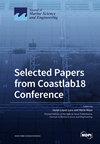通过集合混合 A* 和多目标点人工势场模型进行船舶轨迹规划和优化
IF 2.8
3区 地球科学
Q1 ENGINEERING, MARINE
引用次数: 0
摘要
船舶路径规划是智能船舶自主驾驶的核心问题,也是合理避开障碍物和其他船舶的基础。为实现这一目标,本研究改进了传统的 A* 算法,结合多目标点人工势场算法(MPAPF),提出了一种新的船舶避碰路径规划方法。借助改进的 A* 算法和更少的转弯节点,将全局规划路径平滑分割为多目标序列点。改进后的 APF 算法用于局部规划多目标点的路径,并考虑了船舶运动约束,以生成更符合船舶运动学的路径。此外,该方法还考虑了船舶相遇时的避碰情况,根据《国际海上避碰规则》(COLREGs)进行避碰操作,并引入了碰撞风险指数(CRI)来评估碰撞风险,获得安全可靠的路径。通过对静态环境和船舶相遇的仿真,实验结果表明所提出的方法不仅在静态环境下具有良好的性能,而且在更复杂的相遇场景下也能生成避免碰撞的安全路径。本文章由计算机程序翻译,如有差异,请以英文原文为准。
Ship Trajectory Planning and Optimization via Ensemble Hybrid A* and Multi-Target Point Artificial Potential Field Model
Ship path planning is the core problem of autonomous driving of smart ships and the basis for avoiding obstacles and other ships reasonably. To achieve this goal, this study improved the traditional A* algorithm to propose a new method for ship collision avoidance path planning by combining the multi-target point artificial potential field algorithm (MPAPF). The global planning path was smoothed and segmented into multi-target sequence points with the help of an improved A* algorithm and fewer turning nodes. The improved APF algorithm was used to plan the path of multi-target points locally, and the ship motion constraints were considered to generate a path that was more in line with the ship kinematics. In addition, this method also considered the collision avoidance situation when ships meet, carried out collision avoidance operations according to the International Regulations for Preventing Collisions at Sea (COLREGs), and introduced the collision risk index (CRI) to evaluate the collision risk and obtain a safe and reliable path. Through the simulation of a static environment and ship encounter, the experimental results show that the proposed method not only has good performance in a static environment but can also generate a safe path to avoid collision in more complex encounter scenarios.
求助全文
通过发布文献求助,成功后即可免费获取论文全文。
去求助
来源期刊

Journal of Marine Science and Engineering
Engineering-Ocean Engineering
CiteScore
4.40
自引率
20.70%
发文量
1640
审稿时长
18.09 days
期刊介绍:
Journal of Marine Science and Engineering (JMSE; ISSN 2077-1312) is an international, peer-reviewed open access journal which provides an advanced forum for studies related to marine science and engineering. It publishes reviews, research papers and communications. Our aim is to encourage scientists to publish their experimental and theoretical results in as much detail as possible. There is no restriction on the length of the papers. The full experimental details must be provided so that the results can be reproduced. Electronic files and software regarding the full details of the calculation or experimental procedure, if unable to be published in a normal way, can be deposited as supplementary electronic material.
 求助内容:
求助内容: 应助结果提醒方式:
应助结果提醒方式:


